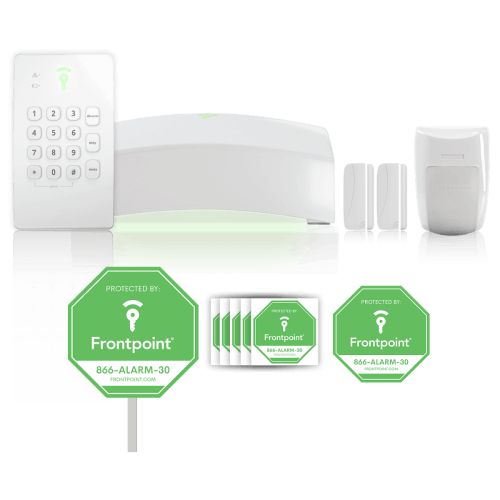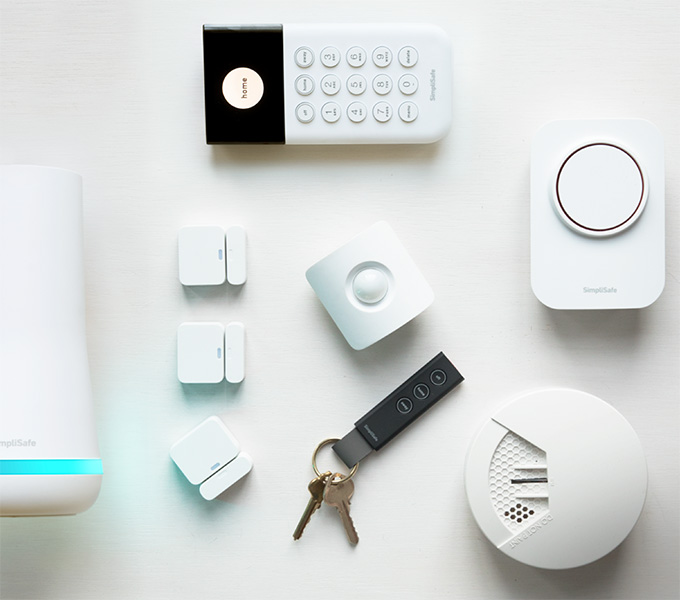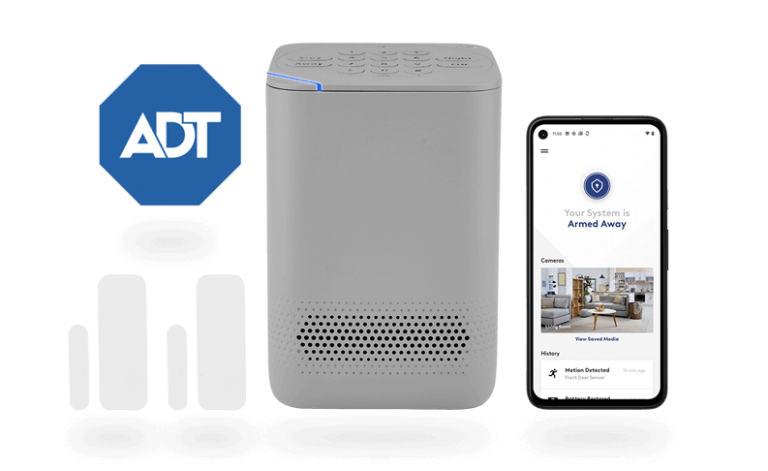We’ll break down the different ways the word is used to help you understand what a company really means when it promotes its system as wireless. But first, here’s a sneak peek at our top recommended wireless security systems. Wireless security systems use radio frequency (RF), Wi-Fi connections, and other technologies to link security sensors to the system hub. Z-Wave and Zigbee are some of the more common alternate wireless technologies used by major security companies. They’re sometimes used for system components, but they’re frequently also used to connect systems to compatible third-party smart home products. Cellular-based systems communicate with your security company’s monitoring center or centers using cell signals instead of communicating through a hardwired connection. Most home security companies allow you to transfer your system to your new place with little hassle, especially if it has DIY installation options. This is great for renters who might switch apartments periodically. However, it’s really expensive. Like, “potentially more than all your streaming subscriptions put together” expensive. And you might run into some customer service snags. For those reasons, Vivint is for people who want the best of the best and aren’t on a budget or don’t want to DIY. Vivint uses both wireless sensors and cellular communication in all of its security packages. It’s one of the leading companies in home automation technology and innovation, and it designs most of its own equipment, including the Vivint video doorbell. For even the most basic package, though, you’ll pay around $600. Plus, the Smart Home plan is cheaper than the video plan. You’ll miss out on cameras, but other than that, you’ll get everything with Smart Home that you get from Vivint’s top-tier package—while saving $4 a month. It’s not always a bad thing—most of the recommendations have merit, but Vivint salespeople are known for being aggressive and even unethical in their pursuit of a higher sale. Which is even more aggravating when you remember that Vivint is already a lot more expensive than its contemporaries. You can get a perfectly good system for about 25% of the cost of what you’ll pay for Vivint. Though Vivint’s sensors are wireless, the control panel needs to be installed by a professional and connected to a power source. It uses cellular technology to communicate with the monitoring center, so it checks both “wireless” boxes. But keep in mind that a technician will drill small holes to install the control panel on your wall. Like Vivint, it’s super pricey. But unlike Vivint, it’s DIY. So if you’re in Vivint price ranges but are all about doing things yourself, Frontpoint might be your sweet spot. In addition to Google, Alexa, and Z-Wave compatibility, Frontpoint gives you home automation control. That includes access to your lights, locks, and thermostat, all from your smartphone. Just remember—you only get an option for one type of monitoring plan for a grand total of $49.99 a month, unless you specifically call to order Frontpoint’s 2-year or month-to-month plans. And that’s without the equipment costs, which start at around $129 for the basic package. In fact, we’d say that Frontpoint has some of the best customer service in the business. If it would just lower its prices a tad, everything about it would be customer-friendly. It’s also cheaper and has 24/7 video recording capabilities, something you don’t usually see in a DIY system. But you gotta pay extra to use the app. Cove doesn’t really do packages; you’ll have to choose the equipment you need yourself. That’s great because you can pick only things you want, but it can also be a little daunting if you’re not familiar with security systems. In addition to the typical security products (control panels, door and window sensors, motion detectors), Cove also sells some extras like CO detectors and medical alert devices. Cove also offers two video doorbells, and a few other security cameras options that aren’t quite up to snuff with the features we see in other security camera systems. Still, Cove is overall much, much less than Vivint or Frontpoint. Also, you’re responsible for installing this whole kit and caboodle yourself. As you’ve probably gleaned, most DIY wireless alarm systems aren’t terribly complicated to put together. But if you consider yourself something of a Luddite, you might need a little assistance. It also uses Wi-Fi for its primary wireless connection but has a cellular backup in case your network ever goes down. SimpliSafe combines a no-contract policy with some of the lowest monitoring prices available. You have the option to pay as you go for cellular monitoring or shut it off completely and monitor the system yourself. You do have to purchase all of your equipment up front, but in the long run, it’s easily the most affordable wireless security solution on our list. You’ll get a lot more bang for your buck with SimpliSafe than most other security brands. SimpliSafe also offers customers of the Interactive monitoring plan 10% off equipment add-ons and a lifetime warranty as long as they maintain their subscription which is a pretty good deal. The Interactive package adds more control to the SimpliSafe system with mobile access and both text and email notifications. While SimpliSafe offers a handful of useful smart devices, like its own smart lock and cameras, it doesn’t connect to most third-party smart home products. So if you want a full-on smart home suite, don’t go with SimpliSafe, which is an island unto itself. But do go with SimpliSafe if you want to play it simple (and safe). You can get your security system set up and armed in a manner of minutes. Still, even if you decide to go pro, ADT Self Setup’s $20-a-month professional monitoring plan isn’t that bad next to Vivint or Frontpoint’s prices. And we really like that you can switch between professional and self-monitoring at will. That’s helpful for anyone with a flexible schedule. We suggest starting with the Starter Plus system. The four door and window sensors and two motion sensors that come in the package should be more than enough to provide a basic safety net for your home. Also, ADT Self Setup has all the cameras you can want or need, and they all come with facial recognition. Like most facial recognition software, ADT Self Setup is a bit rough and doesn’t recognize everyone. But apart from that (and the outdoor camera’s penchant for not staying connected to the Wi-Fi), we like the cameras. They look a lot nicer than most security equipment too. For a best list like this one, which focuses on an aspect of the systems that doesn’t typically weigh heavily in our ranking system, the recommendation order may come out differently than it would in a more standard ranking. You’ll notice that Vivint, for instance, is our top recommendation in this piece but has a lower star ranking overall than Cove.
Old-school security systems have wired sensors that connect directly to a control panel. But these days, most home security systems use radio frequencies (RF) to connect remote sensors (like door/window sensors or motion sensors) to the main hub.Some home automation equipment, like cameras or smart thermostats, uses your in-home Wi-Fi network to communicate with your smartphone security app.
Cellular Some home automation equipment, like cameras or smart thermostats, uses your in-home Wi-Fi network to communicate with your smartphone security app.
Many modern alarm systems use a cellular connection to communicate with a professional monitoring center. This form of wireless communication works the same way as your cellphone and relies on a cellular signal.If you live in a rural area where the cell signal is spotty, this feature may not be available, but you should double-check with the company just to make sure.
If you live in a rural area where the cell signal is spotty, this feature may not be available, but you should double-check with the company just to make sure. Also, most modern users like a wireless security camera to go along with their wireless security system, although there are some hardwired and PoE cameras that we really like. It’s rare to find a camera with all those features, so not every camera we recommend has them. You can learn more in our Best Home Security Cameras Review.






